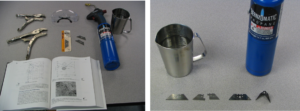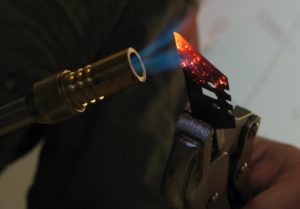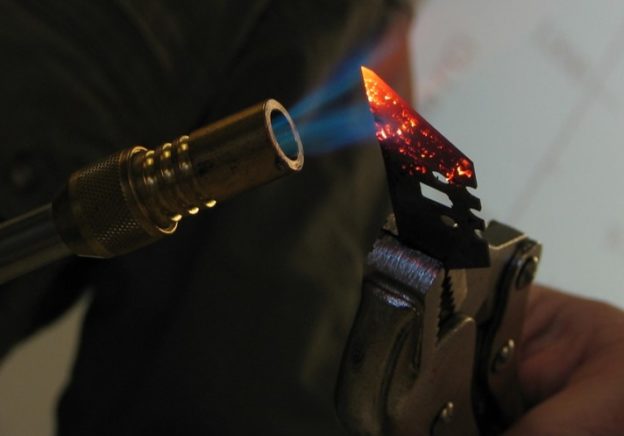Model Description
Knife blades are typically very hard and brittle. In this rapid and inexpensive demonstration, the structure of a steel knife blade is transformed through simple heating and the blade becomes capable of sustaining large deformations without rupture. This demonstration should take 5-7 minutes.
Engineering Principle
Knife blades are typically made of steels with relatively high carbon contents. These steels are also sometimes subjected to aggressive heat treatments which leave them exceptionally hard, strong and brittle. This is particularly true of utility knife blades, which are resistant to deformation (keeping them sharp longer) due to their hardness but have little toughness and thus rupture when subjected to large deformations. By heating the steel utility knife blade to an orange-hot state (perhaps 650 to 700 degrees Celsius), the steel is allowed to go through the initial stages of the annealing process, most likely leading to spheroid structure within the blade. It should be noted that this demonstration is qualitative rather than quantitative, since knowing the initial state of the blade in terms of carbon content or percent martensite, as well as what tempering and annealing went on during manufacturing, is very difficult to determine. Still, the demonstration brings out two key theoretical points. First, the heating and quenching of a sample will not lead to martensitic steels if the heat is insufficient for the formation of austenite. Second, very simple processes can lead to radical changes in material behavior, and engineers must be aware of these potential transformations when designing machines, especially for high-heat settings.
What You Need
| Item | Quantity | Description/Clarification |
|---|---|---|
| Vice Grips | 2 | Vice grips (over pliers) ensure that the broken halves don’t fly off into the gathered crowd. |
| Propane Torch | 1 | A self-igniting torch works best. |
| Container of Water | 1 | One pint is the minimum for quenching the sample. It doesn’t need to be particularly cold, since the blade has little thermal mass. |
| Safety Gear | 1 set |
Keep yourself safe |
| Utility Knife Blade | 2 | Most simple utility blades will work; make sure to test them before class to ensure that the untreated blades break when bent, as not all blades are as brittle as you might like. |
How It’s Done
Before Class: Make sure to test this one thoroughly before trying it in class. Different knife blades can behave very differently, depending on the manufacturing process.

In Class: Begin with the as-manufactured knife blade, and dig into the student’s natural knowledge about the behavior. They should be able to guess what will happen when you grab the sample with the two pairs of vice grips and bend. Let them pick which blade to test, and show them that the blade snaps neatly after just a little bit of bending. Then, take a fresh knife blade and heat it through with a propane torch while holding it with the vice grips (see figure below). During the heating, which should take less than 2 minutes, you can ask the students to give their thoughts on what is likely to happen. Having the phase diagram for steel displayed in the classroom can help fuel the discussion. The blade can then be quick-quenched in the water and the sizzling noise is good drama for keeping student interest. The blade cools almost instantly, and can then be bent back on itself without fracture. This demonstration is an excellent introduction to the topic of heat treating steels. It’s also a great way to illustrate that a mechanical designer must know about the heat treatment of steels to avoid unexpected behavior.

Additional Application: It is easy to relate this demonstration to what students might have seen in the old Western movies. Point out that a blacksmith making a horseshoe had to have a significant amount of knowledge about the heat treatment of steels (post 1870, anyway) in order to make a shoe that was both hard enough and tough enough to take the kind of beating that a galloping horse can dish out.

